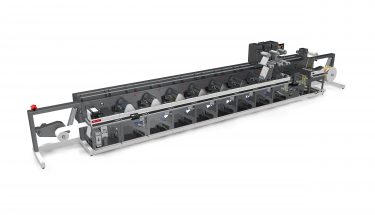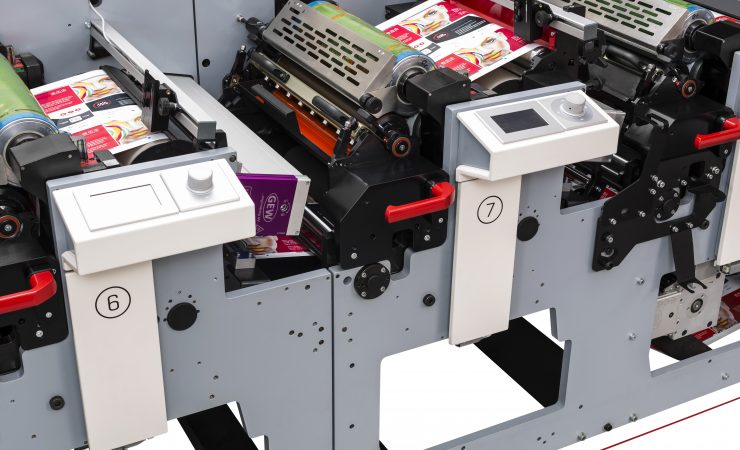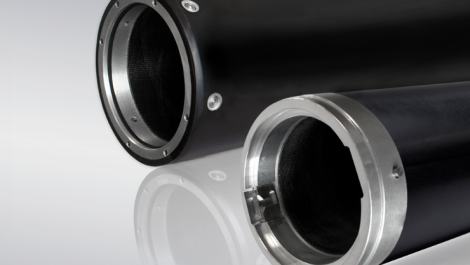Adding automation to a press not only improves the overall productivity but reassures customers of the output quality, by Nessan Cleary.
The great advantage of flexo printing is that it can produce excellent results on a very wide range of different substrates. But this flexibility inevitably means that there are a lot of different elements that have to be correctly set, which makes flexo presses relatively complex machines to operate.
Many people have seen automation as simply being about improving makeready times, so that flexo can remain competitive against offset and digital presses. But increasingly vendors are focusing on automation options that can also help improve the overall print quality and ensure that the results are repeatable. This helps to cut down the amount of substrate that is used to get the press started and the colours stable. But more importantly it also significantly reduces ink and substrate waste caused by colour drift and other problems during the run.
Beyond makeready
However, the degree of automation needed depends mainly on the market area that you are in. Nick Tyrer, sales director for MPS UK, explained, ‘Customers who are involved in printing work for global companies like Proctor & Gamble or Coca-Cola, where they are expected to produce the same work in every country, will use automation because then at least you can get some kind of standardisation towards the product.’ Ultimately the brands are looking to drive up their standards and to minimise their costs and this leads to increasing demands to cut waste and errors right through the supply chain.
Mr Tyrer added that converters need help from technology to achieve this, ‘In part, this comes down to greater use of servo motors. We’ve seen a growing use of servo motors on narrow web presses, mainly because they offer greater tolerances when dealing with flexible films for packaging applications. Servo motors are expensive so there’s an obvious case for limiting the number used to the most useful functions.
‘But servos also enable us to record and store settings that can then be recalled to set up a similar job at a touch of a button. Many vendors still offer a mechanical line driven press with various options for adding on some degree of automation. But in most cases you’ll need to start with a press driven by servo motors to be able to benefit fully from any automation.‘
MPS offers two automation packages for its EF narrow web flexo press; APC and APC Advanced. Mr Tyrer explained, ‘The difference is more servo driven technology around the printhead area so that you can remember where you have been and go back if you want to. You need servo drive technology in the movement between the print cylinders and impression cylinders and so on and can store that in a job memory and then use that information to set up further jobs.’
The APC Advanced adds more servo drives so that further settings such as the plate roll cylinders and material thickness can also be stored in the job memory. Customers for the EF presses will have to specify the degree of automation when ordering the press, but MPS’s XL presses all come with these automation packages as standard.

Nilpeter’s All New FA-line can be run from a table, with operators able to call up job settings from memory
Fine tuning
Omet developed a mix of automation features for its iFlex label press. This includes the use of a laser beam to help operators set pre-register, combined with cameras on each flexo unit to fine tune register for each colour.
Gallus offers different degrees of automation on its various presses, with the most highly automated being the RCS430. It uses direct servo drives throughout so that the printing units can be quickly adjusted for consistent results. It can store setting data on jobs including ink/ water profiles, that can be reused for repeat runs.
Focus Label offers a servo-driven version of its Proflex press, which can be set up with the minimum of fuss with job settings pulled from memory. This also features closed loop tension zones to maintain register within tolerance.
Most of Bobst’s narrow web presses can be fitted with its Digital Automation concept, which essentially means fully automating all of the processes around the press to reduce makeready times and be more competitive against digital printing for shorter runs. The system relies on a camera to locate printed marks to set the register automatically and sensors on the servo motors to correct print pressure.
Nilpeter, which celebrates its centenary this year, introduced its new FA range at the last Labelexpo Europe. This offers complete clean-hand operation from wireless tablets, which can be hand held or positioned anywhere on the front of the machine. There’s also the ability to store and recall jobs, as well as completely automated controls and full connectivity.
The company has also added further automation to its FB range with the introduction of the FB-350, which gains a new Automated Plate Positioning System (APPS) as well as pre-register and re-register functionality.
Inspection systems
However, automation can help to improve printing quality but for a truly closed loop system you need an inspection system to monitor the print output and make adjustments on the fly.
Advanced Vision Technology, better known as AVT, produces several inspection solutions for labelling and packaging. Its main offering for the label sector is Helios, which can be set up on-press or on the rewinders. The most basic version offers 100 percent inspection and there are then further Helios Turbo options to combine this with the press controls. It can even be linked to an MIS to automatically load saved jobs. There’s an option to set up an inline spectrophotometer to monitor the colours inline and it can alert the operator if the colour deviates from the set Delta E value during the print run.
It is worth noting that AVT is owned by the Danaher Group, which also owns Esko. Danaher has sought to exploit synergies between its various companies so that Helios can also be directly connected to Esko’s Automation Engine pre-press workflow.
Edale has developed its Autonomous Inking, Impression and Registration, or AIIR system, which uses a camera with a closed loop inspection system to set up the print register. Edale has integrated AVT’s Helios S camera technology and added its own software along with additional servo motors on each print station to adjust the print impression, inking and cross register to ensure the highest print quality.
The system relies on registration marks printed on each station, which the Helios system picks up and the sends corrections to the respective print stations. The Edale tracking software ensures that no further corrections are made until the initial corrections have passed the camera. It can automatically position the pressure settings based on saved job data or material caliper and uses operator defined profiles to adjust pressure relative to press speed. In addition, the AVT system automates the initial setting of inking and print pressure at the start of each new job.
BST Electromat has developed a modular automation platform that can be integrated into a flexo press. This promises to improve print output, minimise waste and improve the overall efficiency of the press. It can be retrofitted to existing presses and covers everything from 100% inspection through to register control and web guiding.
Baldwin Vision Systems, which now owns QuadTech, has developed a number of press control systems around its core inspection technology. This includes the Autotron 2600 with Clearlogic, which can pick up registration marks to automate register settings. There’s also the QuadTech Inspection System, which offers defect detection, and can be combined with SpectralCam for colour measurement.
As flexo presses become increasingly automated, information on their performance could be fed into an MIS and used to monitor the press. However, the press itself is only part of the process and there is little point in spending money to automate one area if you do not also take into account all of the processes around the press. Ultimately, automation is about investing to integrate the
whole process.






